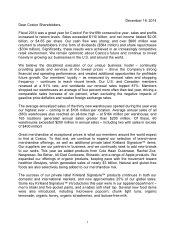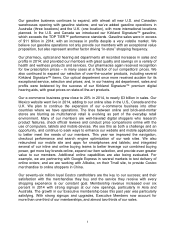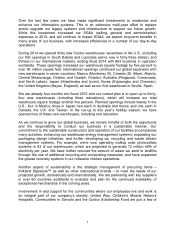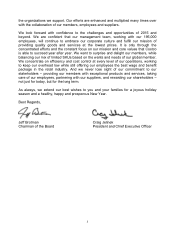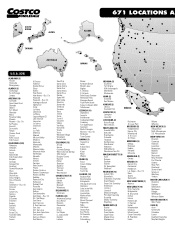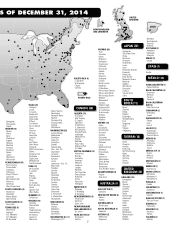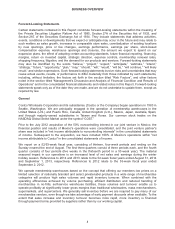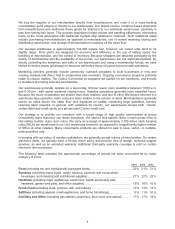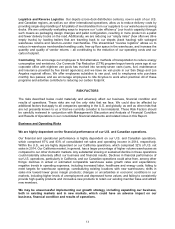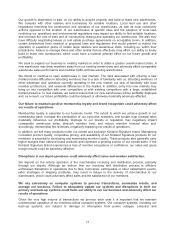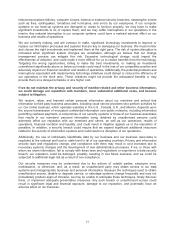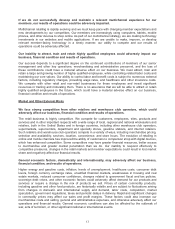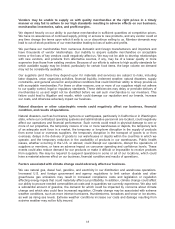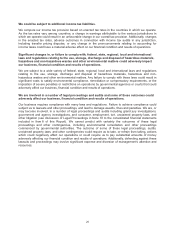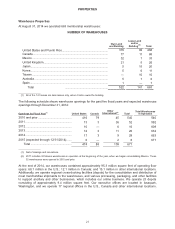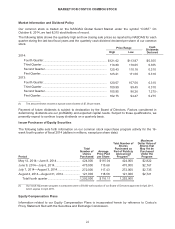Costco 2014 Annual Report Download - page 14
Download and view the complete annual report
Please find page 14 of the 2014 Costco annual report below. You can navigate through the pages in the report by either clicking on the pages listed below, or by using the keyword search tool below to find specific information within the annual report.SUSTAINABILITY: ENERGY MANAGEMENT, CONSERVATION AND THE “GREENING” OF COSTCO
Corporate Sustainability and Energy Group We are mindful of our responsibilities as an environmental
steward in managing our global operations in an energy-efficient and environmentally-friendly manner.
Our Corporate Sustainability and Energy Group is actively involved in developing solutions for aspects of
our business related to sustainability, including: seeking to reduce our carbon footprint; enhancing our
warehouse energy management systems; refining our packaging design initiatives and the “cube
efficiency” of our merchandise distribution systems; and further developing our recycling and waste
stream management programs.
Greenhouse Gas Program We have implemented a corporate energy program to track greenhouse gas
(GHG) emissions. We have ceased using HCFC refrigerant, an ozone-depleting substance, in new and
replacement refrigeration and air conditioning systems. We have completed a greenhouse gas emissions
inventory for our operations in the U.S., Puerto Rico, Canada, the United Kingdom and Australia that
meets standards established by the GHG Protocol Corporate Accounting and Reporting Standard. The
inventory accounts for greenhouse gasses emitted into the atmosphere from Company activities
(including direct emissions from our own energy-use activities and indirect emissions from our purchased
electricity). We use this inventory to track emission trends and to monitor the amount of greenhouse
gases produced directly and indirectly in our business.
Sustainable Construction, Renewable Energy and Energy Efficiency The organization Leadership in
Energy and Environmental Design (LEED) is nationally accepted as a benchmark for green building
design and construction. Costco’s metal warehouse design, one of the warehouse design styles we have
most frequently built over the past several years, is consistent with the requirements of the Silver Level
LEED Standard. Our metal building envelopes are all insulated to meet or exceed current energy code
requirements, and our main building structures use 80% recycled steel materials designed to minimize
the amount of material utilized. The roof materials used on our metal pre-engineered warehouses are
recycled standing seam metal panels, designed to maximize efficiency for spanning the structure; and the
exterior skin of the building is also recycled metal.
This past year we increased the number of large rooftop solar photovoltaic systems to 83 warehouses –
in Hawaii, California, New Mexico, New Jersey, Puerto Rico, Colorado, Arizona, New York, and Japan.
These systems are projected to generate 72 million kWh of electricity per year. We also continue to
expand the use of non-chemical water treatment systems used in our cooling towers, to reduce the
amount of chemicals going into sewer systems and, where possible, reuse that water for site irrigation. By
coordinating with state and federal incentive programs, these and other energy-saving systems help us
lower the cost of operating our facilities.
In recent years we have made notable progress in lowering the power consumption of the lighting
systems in our buildings by as much as 50% while actually improving the lighting quality with the use of
LED fixtures. Our HVAC systems are as much as 15% more efficient over the last several years, while at
the same time meeting stricter requirements for heating, cooling, and humidity control. Our refrigeration
systems have also become more efficient even as we have increased the size of our coolers and freezers
to support higher sales volumes. We continue to evaluate additional opportunities to improve energy
efficiency.
Recycling and Waste Stream Management Tons of trash that our warehouses generate each week,
much of which was once discarded into landfills, are now being recycled into usable products, recycled
into biofuels or compost, or used as feed stock. We also have a warehouse program where meat scraps
and rotisserie chicken grease are recycled by third parties to make animal feed, biodiesel fuel, soaps, and
other products. Our grease recovery systems, now in most of our warehouses, annually divert millions of
pounds of grease from the waste stream. In 2014 we diverted 325,000 tons of material from landfills and
sent it to recycling facilities. We recycled 216,000 tons of baled corrugate and our electronic waste (E-
waste) diversion program recycled 4,508 tons. Our merchandise packaging is also becoming more
sustainable as we pursue opportunities to eliminate polyvinyl chloride (PVC) plastic in our packaging and
replace it with recycled or recyclable materials.
12


